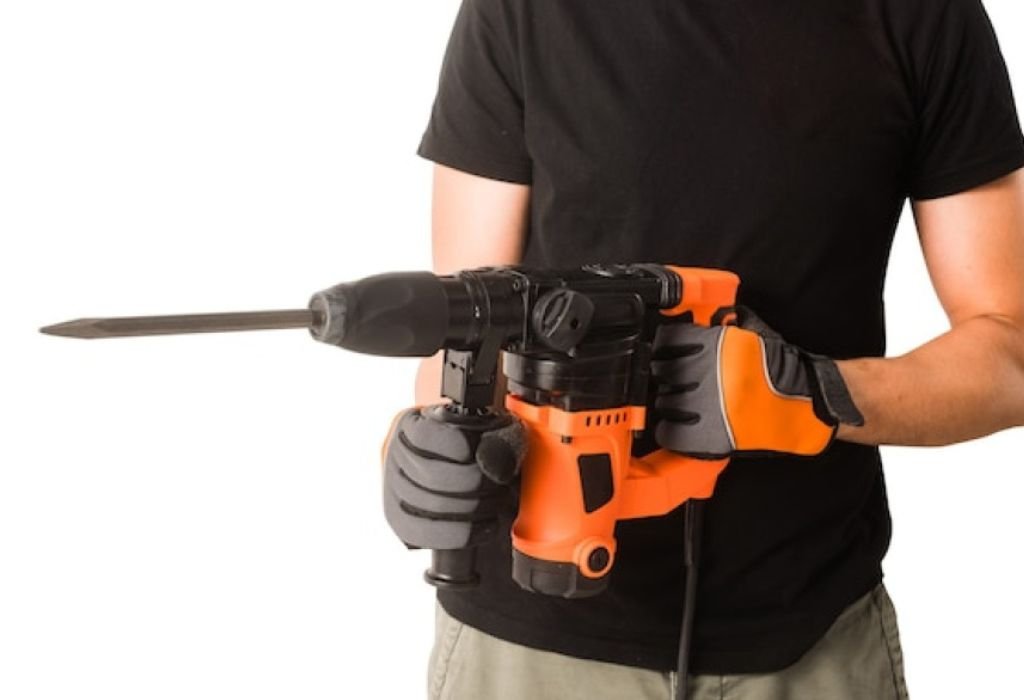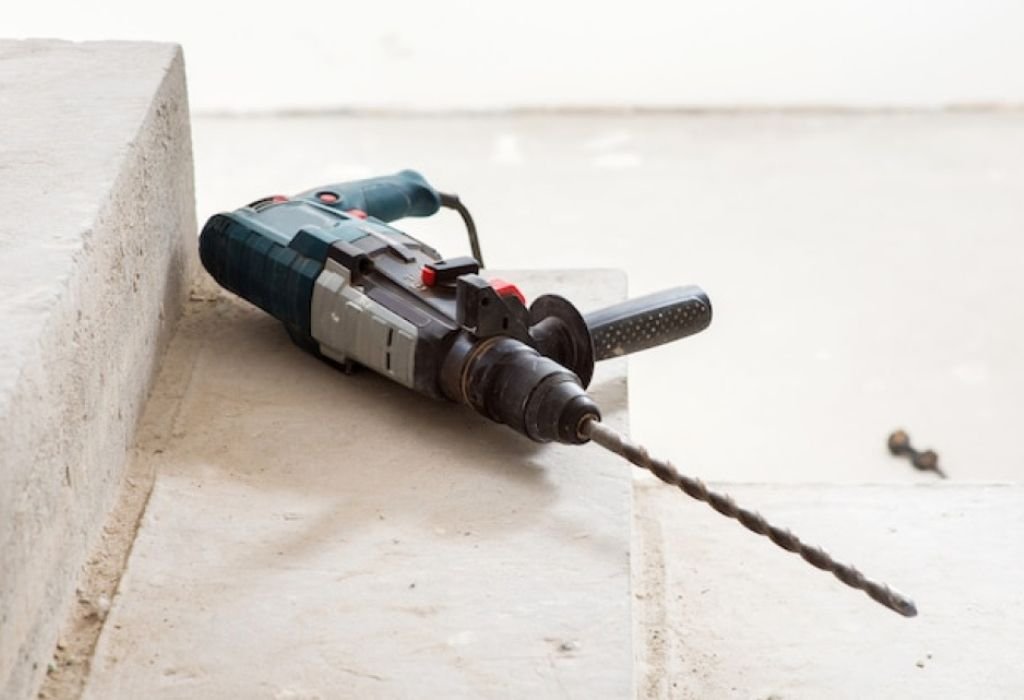A homeowner stands in the driveway, holding a rented rotary hammer, ready to tear up old concrete.
The tool looks powerful, but a thought arises: can a rotary hammer be used as a jackhammer?
The two tools seem similar, each designed to break through tough surfaces.
But their differences become clear when the job demands raw power versus versatility.
Rotary hammers are versatile machines capable of drilling, chiseling, and light demolition.
Jackhammers, in contrast, are pure demolition beasts designed for heavy-duty breaking.
The global demolition equipment market is projected to surpass $9 billion by 2030, showing how demand for these tools is growing rapidly in construction (Grand View Research).
Knowing when to use each tool can save time, money, and frustration.
This guide explains whether a rotary hammer can truly replace a jackhammer, how they differ, and when each is the right choice.
Quick Answer — Can a Rotary Hammer Be Used as a Jackhammer?

A rotary hammer can be used like a jackhammer for light demolition tasks such as chiseling tiles, removing bricks, and breaking thin concrete slabs. With chisel or spade bits, it delivers enough power for small to medium projects.
But rotary hammers cannot replace jackhammers in industrial jobs. Jackhammers are built for breaking thick slabs, asphalt, and heavy concrete where more impact energy is needed.
Can a rotary hammer break concrete?
Yes, but mainly for thinner sections.
Is it as powerful as a jackhammer?
No, jackhammers produce much higher impact force.
When should you use a rotary hammer?
For tile removal, brickwork, and light concrete demolition.
When is a jackhammer needed?
For large-scale demolition like roads and thick foundations.
Which is more DIY-friendly?
Rotary hammers are lighter and easier for homeowners.
Anatomy of a Rotary Hammer vs. Jackhammer
A rotary hammer uses a piston-driven mechanism that combines drilling rotation with hammering impact. It has modes for drilling, hammer drilling, and chiseling.
Jackhammers work differently. They deliver pure impact without rotation, using pneumatic, electric, or hydraulic systems for maximum breaking power.
Rotary hammers often use SDS-Plus or SDS-Max chuck systems to secure bits. Jackhammers, however, use heavy-duty steel chisels designed only for pounding.
Weight is another difference. Rotary hammers weigh between 6–20 lbs, while jackhammers can exceed 60 lbs, making them harder to control for long sessions.
Do jackhammers drill holes?
No, they only break materials.
Do rotary hammers require air compressors?
No, unlike pneumatic jackhammers.
Which is heavier?
Jackhammers are much heavier.
Which is more versatile?
Rotary hammers, since they can drill and chisel.
Which reduces fatigue?
Rotary hammers are easier to handle over time.
Applications of Rotary Hammers and Jackhammers
Rotary hammers are best for medium-duty jobs. They excel at drilling anchor holes, removing tiles, chiseling bricks, and breaking thinner slabs of concrete.
Jackhammers are used for demolition projects that require raw strength. These include breaking asphalt roads, thick concrete foundations, and large-scale industrial work.
A rotary hammer is often used in home renovation projects. Jackhammers are mostly found in construction and roadwork.
Contractors may keep both tools, using the rotary hammer for precision and the jackhammer for brute force.
Can rotary hammers remove tiles?
Yes, with flat chisel bits.
Are jackhammers used indoors?
Rarely, due to vibration and noise.
Which tool works for asphalt?
Jackhammers are better for this task.
Which suits small projects?
Rotary hammers are ideal.
Which requires more PPE?
Jackhammers, due to higher noise and vibration.
Pros and Cons of Using a Rotary Hammer as a Jackhammer
Rotary hammers are lighter, cheaper, and more versatile. They can perform multiple functions beyond demolition, making them valuable for DIY and contractors.
But rotary hammers lack the impact energy of jackhammers. Overusing them on heavy demolition jobs can damage the tool or shorten its lifespan.
For small-scale projects, using a rotary hammer as a jackhammer can save money. For large jobs, it’s inefficient and impractical.
This balance makes rotary hammers the right choice for home projects, while jackhammers remain essential for industrial work.
Is it cost-effective?
Yes, for light projects.
Does it save time?
Yes, but only on smaller jobs.
Can it damage the tool?
Yes, if overworked.
Does it need special bits?
Yes, chisel or spade bits are required.
Can it replace rentals?
Sometimes, for small demolition tasks.
Safety and Maintenance Considerations
Using either tool requires proper safety precautions. PPE such as gloves, goggles, dust masks, and hearing protection is essential.
Rotary hammers can overheat if pushed too hard on demolition projects. Allowing cool-down periods helps extend their lifespan.
Jackhammers pose higher risks due to vibration and weight. Anti-vibration handles and frequent breaks reduce fatigue.
Both tools need regular maintenance, including lubrication of bits and cleaning of dust-filled vents.
Is vibration a concern?
Yes, especially with jackhammers.
Can rotary hammers overheat?
Yes, during extended demolition.
Do jackhammers need training?
Yes, due to their size and power.
Are rotary hammers safe for DIY?
Yes, with proper use.
How to extend tool life?
Clean and lubricate regularly.
Choosing the Right Tool for the Job

Rotary hammers are the better choice for small-scale demolition, home renovations, and jobs that require versatility. They are lighter and easier to control.
Jackhammers are best for professional construction projects. Their raw power makes them the only option for thick concrete and asphalt.
SDS-Max rotary hammers act as a middle ground, offering more power than small rotary hammers while still being easier to handle than jackhammers.
Cost is another factor. Rotary hammers are cheaper to buy and rent, while jackhammers are more expensive but necessary for industrial-scale demolition.
Which is cheaper to rent?
Rotary hammers.
Which lasts longer under stress?
Jackhammers in heavy demolition.
Which suits contractors?
Jackhammers for major projects.
Which suits homeowners?
Rotary hammers.
Is SDS-Max a good compromise?
Yes, for those who need extra power.
Future of Rotary Hammers vs. Jackhammers
Rotary hammers are evolving with cordless models that pack more power each year. Battery-powered SDS-Max tools are bridging the gap between drilling and demolition.
Jackhammers will remain dominant in heavy industry. Their unmatched impact energy ensures they stay essential for roadwork and infrastructure projects.
DIY users will continue to favor rotary hammers. Their lighter weight and versatility make them more accessible for non-professionals.
Innovation in vibration reduction is improving both tools, making them safer and more comfortable to use.
Will rotary hammers replace jackhammers?
No, but they complement them.
Are cordless rotary hammers reliable?
Yes, for medium demolition.
Is vibration reduction improving?
Yes, with advanced AVT systems.
Which tool is growing in DIY demand?
Rotary hammers.
Will jackhammers get smaller?
Unlikely, due to their power needs.
Conclusion
So, can a rotary hammer be used as a jackhammer? The answer is yes, but only for light demolition tasks. For tiles, bricks, and thinner slabs, rotary hammers are more than capable.
For heavy-duty projects like thick concrete or asphalt, jackhammers are the only efficient choice. The difference comes down to impact energy and purpose.
Rotary hammers win on versatility and ease of use. Jackhammers dominate when brute force is required.
Final advice: choose based on your project scale. A rotary hammer is enough for home jobs, but when concrete gets serious, nothing beats a jackhammer.

I’m John F. Nicholas, the founder, lead writer, and drill enthusiast behind 101drill.com. With years of hands-on experience in power tools and DIY projects, I created this platform to share practical knowledge, expert tips, and real-world insights to help others master the art of drilling.
